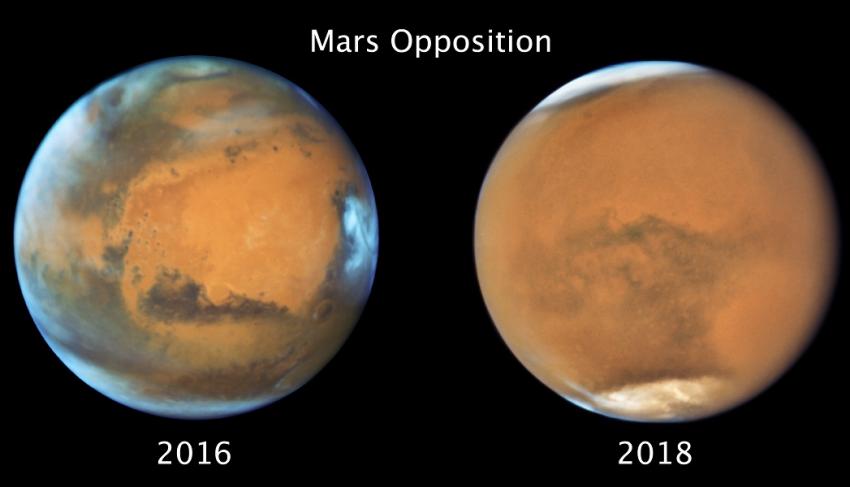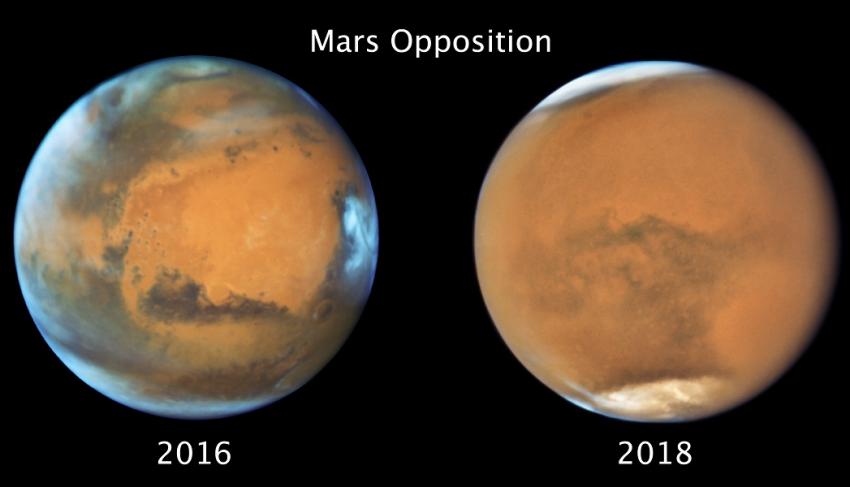A dust storm that engulfed the entire Red Planet in 2018 destroyed a vortex of cold air around the Martian south pole and brought an early spring to the hemisphere. By contrast, the storm caused only minor distortions to the polar vortex in the northern hemisphere and no dramatic seasonal changes. Dr Paul Streeter of The Open University’s Faculty of Science, Technology, Engineering and Mathematics will present the work today (23 July) at the virtual National Astronomy Meeting (NAM 2021).
Over two weeks at the beginning of June 2018, localised dust storms combined and spread to form an impenetrable blanket of dust that hid almost the entire planet’s surface. The global dust storm, which coincided with Mars’s equinox and lasted until mid-September, proved fatal to NASA’s solar-powered Opportunity rover.
Streeter and colleagues from The Open University, NASA and the Russian Academy of Sciences examined the effects of the event on the Martian atmosphere by combining data from a Mars Global Climate Model with observations from the European Space Agency’s ExoMars Trace Gas Orbiter and NASA’s Mars Reconnaissance Orbiter missions.
Streeter says: “This was a perfect opportunity to investigate how global dust storms impact the atmosphere at the Martian poles, which are surrounded by powerful jets of wind in winter. Since the last global storm in 2007, several new missions and instruments have arrived in Mars orbit, so the 2018 event was the most-observed to date.”
Previous research has shown that high levels of dust in the atmosphere can have significant effects on polar temperatures and winds. The vortices at the winter poles also affect temperatures and the transport of air, dust, water and chemicals, so their disruption could mean substantial changes in the Martian atmosphere.
The team found that the 2018 storm had profoundly different effects in each hemisphere. At the south pole, where the vortex was almost destroyed, temperatures rose and wind speeds fell dramatically. While the vortex may have already been starting to decay due to the onset of spring, the dust storm appears to have had a decisive effect in ending winter early.
The northern polar vortex, by contrast, remained stable and the onset of autumn followed its usual pattern. However, the normally elliptical northern vortex was changed by the storm to become more symmetrical. The researchers link this to the high dust content in the atmosphere suppressing atmospheric waves caused by the extreme topography in the northern hemisphere, which has volcanoes over twice as tall as Mount Everest and craters as deep as terrestrial mountains.
Streeter adds: “Global dust storms at equinox may enhance transport into the southern pole due to the diminished vortex, while the more robust northern vortex continues to act as an effective barrier. If this pattern for global dust storms holds over the course of the thousands of years that Mars maintains this particular axial tilt, it has implications for how dust is deposited at the north and south poles and our understanding of the planet’s climate history.”
Media contacts
Anita Heward
Royal Astronomical Society
Mob: +44 (0)7756 034 243
nam-press@ras.ac.uk
Dr Robert Massey
Royal Astronomical Society
Mob: +44 (0)7802 877 699
nam-press@ras.ac.uk
Dr Morgan Hollis
Royal Astronomical Society
Mob: +44 (0)7802 877 700
nam-press@ras.ac.uk
Vittoria D'Alessio
PR and Media Manager
University of Bath
Tel: +44 (0)1225 383 135
vda26@bath.ac.uk
Philippa Green
Media Relations
The Open University
Philippa.green@open.ac.uk
Science contacts
Dr Paul Streeter
School of Physical Sciences
Faculty of Science, Technology, Engineering and Mathematics
The Open University
paul.streeter@open.ac.uk
Images, animations and captions
Side-by-side movies show how the 2018 global dust storm enveloped the Red Planet, courtesy of the Mars Color Imager (MARCI) camera onboard NASA's Mars Reconnaissance Orbiter (MRO).
Credit: NASA / JPL-Caltech / MSSS
Further information
The work appears in: “Asymmetric Impacts on Mars’ Polar Vortices From an Equinoctial Global Dust Storm”, P.M. Streeter et al., JGR Planets 126 (5) (2021) (DOI: 10.1029/2020JE006774)
Notes for editors
About the National Astronomy Meeting
The Royal Astronomical Society National Astronomy Meeting (NAM 2021) will take place online from 19 - 23 July 2021. Bringing together around 800 astronomers and space scientists, the conference is the largest annual professional astronomy and space science event in the UK, and sees leading researchers from around the world presenting their latest work.
NAM 2021 incorporates the annual meetings of the Magnetosphere Ionosphere Solar-Terrestrial (MIST) and UK Solar Physics (UKSP) groups. The conference is principally sponsored by the Royal Astronomical Society (RAS), the Science and Technology Facilities Council (STFC) and the University of Bath.
Follow NAM 2021 on Twitter
About the Royal Astronomical Society
The Royal Astronomical Society (RAS), founded in 1820, encourages and promotes the study of astronomy, solar-system science, geophysics and closely related branches of science. The RAS organises scientific meetings, publishes international research and review journals, recognises outstanding achievements by the award of medals and prizes, maintains an extensive library, supports education through grants and outreach activities and represents UK astronomy nationally and internationally. Its more than 4,000 members (Fellows), a third based overseas, include scientific researchers in universities, observatories and laboratories as well as historians of astronomy and others.
Follow the RAS on Twitter, Facebook, Instagram and YouTube
Download the RAS Supermassive podcast
About the Science and Technology Facilities Council
The Science and Technology Facilities Council is part of UK Research and Innovation – the UK body which works in partnership with universities, research organisations, businesses, charities, and government to create the best possible environment for research and innovation to flourish. STFC funds and supports research in particle and nuclear physics, astronomy, gravitational research and astrophysics, and space science and also operates a network of five national laboratories as well as supporting UK research at a number of international research facilities including CERN, FERMILAB and the ESO telescopes in Chile. STFC is keeping the UK at the forefront of international science and has a broad science portfolio and works with the academic and industrial communities to share its expertise in materials science, space and ground-based astronomy technologies, laser science, microelectronics, wafer scale manufacturing, particle and nuclear physics, alternative energy production, radio communications and radar.
STFC's Astronomy and Space Science programme provides support for a wide range of facilities, research groups and individuals in order to investigate some of the highest priority questions in astrophysics, cosmology and solar system science. STFC's astronomy and space science programme is delivered through grant funding for research activities, and also through support of technical activities at STFC's UK Astronomy Technology Centre and RAL Space at the Rutherford Appleton Laboratory. STFC also supports UK astronomy through the international European Southern Observatory.
Follow STFC on Twitter
About the University of Bath
The University of Bath is one of the UK's leading universities both in terms of research and our reputation for excellence in teaching, learning and graduate prospects.
The University is rated Gold in the Teaching Excellence Framework (TEF), the Government’s assessment of teaching quality in universities, meaning its teaching is of the highest quality in the UK.
In the Research Excellence Framework (REF) 2014 research assessment 87 per cent of our research was defined as ‘world-leading’ or ‘internationally excellent’. From developing fuel efficient cars of the future, to identifying infectious diseases more quickly, or working to improve the lives of female farmers in West Africa, research from Bath is making a difference around the world. Find out more
Well established as a nurturing environment for enterprising minds, Bath is ranked highly in all national league tables. We are ranked 6th in the UK by The Guardian University Guide 2021, and 9th in The Times & Sunday Times Good University Guide 2021 and 10th in the Complete University Guide 2021. Our sports offering was rated as being in the world’s top 10 in the QS World University Rankings by Subject in 2021.
About The Open University
The Open University (OU) is the largest academic institution in the UK and a world leader in flexible distance learning. Since it began in 1969, the OU has taught more than two million students worldwide and has over 175,000 current students, including more than 7,000 overseas.
Over 76% of students are in full-time or part-time employment, and three out of five FTSE 100 companies have sponsored staff to take OU courses.
In the latest assessment exercise for university research (Research Excellence Framework, 2014), nearly three quarters (72%) of OU research was assessed as 4 or 3 star – the highest ratings available, awarded to research that is world-leading or internationally excellent. The OU is unique among UK universities having both an access mission and demonstrating research excellence.
Regarded as the UK’s major e-learning institution, the OU is a world leader in developing technology to increase access to education on a global scale. Its vast ‘open content portfolio’ includes free study units, as well as games, videos and academic articles, which have reached over 36 million people.
For further information please visit The Open University



